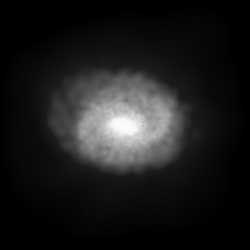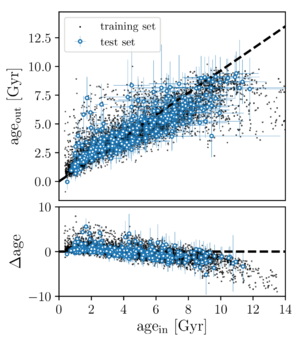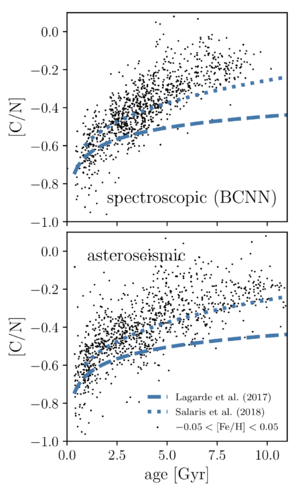
Figure 1
The Galactocentric R-z distribution of stars in the APOGEE-Gaia sample

The kinematics of the Milky Way disc as a function of age are well measured at the solar radius, but have not been studied over a wider range of Galactocentric radii. Here, we measure the kinematics of mono-age, mono-[Fe/H] populations in the low and high [α/Fe] discs between 4 < R < 13 kpc and |z| < 2 kpc using 65,719 stars in common between APOGEE DR14 and Gaia DR2 for which we estimate ages using a Bayesian neural network model trained on asteroseismic ages. We determine the vertical and radial velocity dispersions, finding that the low and high [α/Fe] discs display markedly different age--velocity-dispersion relations (AVRs) and shapes σz/σR. The high [α/Fe] disc has roughly flat AVRs and constant σz/σR = 0.64, whereas the low [α/Fe] disc has large variations in this ratio which positively correlate with the mean orbital radius of the population at fixed age. The high [α/Fe] disc component's flat AVRs and constant σz/σR clearly indicates an entirely different heating history. Outer disc populations also have flatter radial AVRs than those in the inner disc, likely due to the waning effect of spiral arms. Our detailed measurements of AVRs and σz/σR across the disc indicate that low [α/Fe], inner disc (R < 10 kpc) stellar populations are likely dynamically heated by both giant molecular clouds and spiral arms, while the observed trends for outer disc populations require a significant contribution from another heating mechanism such as satellite perturbations. We also find that outer disc populations have slightly positive mean vertical and radial velocities, likely because they are part of the warped disc.
The gallery below contains the figures from the paper. Click panels for PDFs.

The Galactocentric R-z distribution of stars in the APOGEE-Gaia sample

The [Fe/H]-[α/Fe] distribution of stars in the sample coloured by the mean stellar age in each bin. The transparency of the bins is proportional to the number of stars in each bin

Stellar age against [α/Fe] and [Fe/H] for the APOGEE-Gaia sample, coloured by the mean value of the other parameter. Transparency is as in Figure 2.

The radial and vertical velocity dispersion of mono-age, mono-[Fe/H] populations as a function of height above the midplane |z|.

The radial and vertical velocity dispersion of mono-age, mono-[Fe/H] populations as a function of stellar age. Points are coloured by the mean orbital radius in each mono-age, mono-[Fe/H] bin.

The shape of the radial and vertical age-velocity dispersion relationship (AVR) as a function of the mean orbital radii.

The σz/σR of mono-age, mono-[Fe/H] populations as a function of stellar age.

The mean velocity in the radial and vertical direction, as a function of mean orbital radius for mono-age mono-[Fe/H] populations.

σz/σR as a function of |z| for low and high [α/Fe] populations.

Stellar ages from APOKASC-2 (training set) against the age predicted by the Bayesian convolutional neural network (BCNN) model

Stellar ages from APOKASC-2 (training set) and those predicted by the BCNN plotted against the ratio of carbon to nitrogen abundance from APOGEE
Another useful outcome of this paper was the development of a catalogue of stellar ages for stars in APOGEE which has higher precision, accuracy and coverage than, for example, age catalogues based on isochrone fitting. The application of a Bayesian convolutional neural network from astroNN allowed for the proper treatment of observational uncertainties when training the model and produced an age catalogue with a slightly higher precision and accuracy than can be produced using simpler polynomial regression analysis on the abundances themselves (e.g. Martig et al. 2016).
The age catalogue for APOGEE DR14 stars (which have good spectra and have [Fe/H] > -0.5, as discussed in the paper) is made publicly available as supplementary material with the paper. The catalogue is available to download (possibly temporarily) as a FITS table here. This table contains only the 2MASS identifier for each star, labelled here as APOGEE_ID, the astroNN age labelled as astroNN_age, and the uncertainties which are returned by astroNN astroNN_age_total_std, astroNN_age_predictive_std, and astroNN_age_model_std. astroNN_age_total_std is the number which should be used for the formal uncertainties when using the catalogue.
In addition to that table, we also made public a table which contains the ages predicted by the BCNN for the training data alongside the input age from APOKASC-2. That table can be downloaded at this link. Please direct any queries regarding these data to myself.